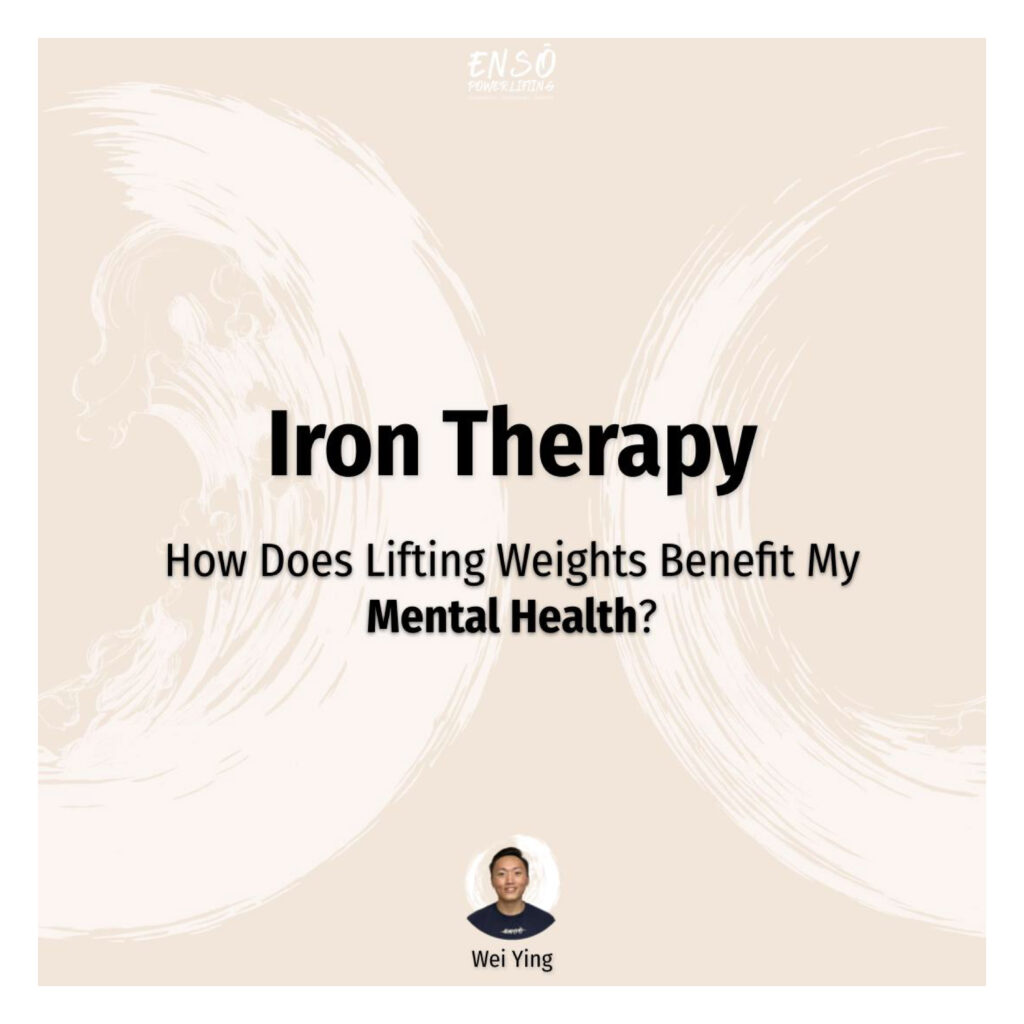
TAN “CAIFAN” WEI YING
Wei Ying is a mixed vegetables rice connoisseur who can solve a Rubik’s cube while squatting his max. He is also an associate Psychologist who did his thesis on music in powerlifting at NUS. His keen interest in muscle dysmorphia (bigorexia) and sports psychology inspires him to bring more awareness on sports psychology and mental health into the realm of resistance training. With 7 years of experience in powerlifting, Wei Ying has contributed greatly to the community as the ex-President of Powerlifting NUS, the Vice-President of TheGymNation, and as an IPF referee. He also organized the first-ever Test of Strength (2018).
Resistance training (RT) has colloquially been associated with fat loss and muscle gain, along with its numerous physical benefits. These include coping with health issues such as Type-2 diabetes, improving bone density, weight management, and heart disease and osteoporosis prevention. In fact, muscular strength has been associated with reduced all-cause mortality in men. (Latham et al., 2004; Chodzko-Zajko et al., 2009; Liu & Latham, 2009; Ruiz et al., 2008). Markers of progress associated with the personal training industry mainly focus around body re-compositions and aesthetic improvements, further accentuating the physical benefits of RT.
Aside from the benefits it has on physical health, RT can also improve our quality of life in the present and subsequently in our later years. Being physically strong allows us to climb staircases, decrease our risk of injuries, carry our children, and open the occasional tight jar. Can you imagine the reduced functionality of our bodies if we were not physically strong?
When we think of the mental health benefits of RT, we often associate it with an increased self-esteem, self-confidence, and body image (SantaBarbara, 2017). As strength training enthusiasts (or powerlifters if you identify as such), lifting weights can help us feel better and help us to cope with our stressors. In more recent times, research into mental health benefits of RT has examined the potential healing effects on psychological conditions such as anxiety, depression, and trauma (Gordon et al., 2017; O’connor et al., 2010; O’Sullivan et al., 2023; Whitworth et al., 2019). This expands the potential utility that RT can have in the health space and more holistic treatments which medical practitioners can prescribe for such psychological conditions.
Now before anyone rushes to the gym to combat depression, the evidence shown is only preliminary and cannot be used as the primary form of treatment for psychological conditions yet. Lifting weights is not advised to replace the gold standard psychological therapy or pharmacological treatments, period. There is much more to understand, as we identify the mechanisms behind the improvement of these conditions. While we may feel better after a solid lifting session, it may function better as a coping strategy to help us get through our struggles.
Mental Health Benefits
As mentioned earlier, we often associate mental health benefits of RT with improved self-esteem and self-confidence that one gets from their physique transformation, which in turn improves body image. To the casual gym-goer, this may improve their mood on a day-to-day basis and their confidence outside of the gym. Studies by O’connor et al. (2010) & O’Sullivan et al. (2023) found that strength training was associated with reductions in anxiety symptoms, depressive symptoms and fatigue, and these effects are consistent in benefitting both healthy individuals and those suffering from psychological conditions.
In a meta-analysis of randomized controlled trials that studied the effects of resistance training on anxiety, RT led to significant reductions in anxiety symptoms in both healthy adults and individuals diagnosed with physical and mental illnesses (Gordon et al., 2017). In fact, the effects did not vary according to sex, age, frequency, intensity, or even strength gains. Simply put, if you are healthy or are diagnosed with an anxiety-related disorder, RT can help you with managing symptoms due to its anxiolytic effects.
How does this work exactly? It’s currently unclear what the mechanism that leads to the reduction in symptoms of anxiety is. Several theories include the Cross-stressor hypothesis (Sothmann et al., 1996), where repeated exposure to a specific stressor of enough intensity and time, can facilitate adaptations in the stress response system. This system is often triggered when we are in stressful (relative) situations where the body responds by releasing adrenaline, increasing heart rate, and heightening its senses. Repeated exposure via RT helps individuals with anxiety reduce their sensitivity to these sensations, normalizing these responses when they occur in future.
RT and Trauma Healing
An interesting wave in research recently revolves around the use of RT for an adjunct treatment of trauma (Nowakowski-Sims et al., 2023). Experiences of traumatic events can create relational and bodily disconnection, resulting in dissociation from the self at times (Herman, 2015). During traumatic experiences, the body moves towards survival mode and creates automatic and unconscious dissociative responses. This can result in hyper/hypo vigilance (being constantly on edge/low sensitivity), impulsivity, and sensory dysregulation in the body.
Insert resistance training as an adjunctive treatment for trauma. Much like mindfulness, where participants focus on the here and now, resistance training helps patients to address the physiological dysregulation and somatic symptoms of trauma by grounding them in the moment (Statler and Dubois, 2021) and helping them regain sensations in their bodies.
Think of yourself doing a set of bicep curls, focusing on the squeeze when contracting your bicep. In that moment, the thoughts that run through your mind are solely focused on how you’re moving the dumbbell and chasing the pump. There aren’t other thoughts about feeling inadequate, worries about the future, or fears about the externals.
In individuals suffering from trauma, this experience helps to create awareness of what is happening in the body, feeling body parts they might have lost sensation in or have become numb to, in a safe environment. In turn, this allows them to translate these experiences of strength into empowerment.
As physical health improves, well-being and mental health improves as well. Good experiences in training leads to positive appraisals and influence on thoughts about themselves, reshaping the ways they see about themselves, the world, and their situations. At worst, resistance training also acts as a healthier coping mechanism and lead to reduced use of detrimental coping mechanisms such as substance use or self-harm.
Often overlooked is the community that is formed in the gym and the potential healing effects that they have. Trauma survivors often rely on those around them for support and the gym can become one of those places. Many of us enjoy the company of our fellow powerlifting cliques, and the social interaction during training often improves our mood after a long day of school/work.
Is Lifting Therapy?
As discussed above, RT can have cathartic and therapeutic effects and be used as a form of coping. We do have to recognise that while methods of coping may allow us to temporarily deal with the stress you are facing, they may not resolve the root issue. In fact, such coping mechanisms can sometimes be overused to compensate for the struggles in our lives. In the same vein, alcohol is often misused similarly. A drink or two may take the edge off after a long day of work, but using alcohol to cope in the long run ends up avoiding the problem at hand. Ultimately, there will come a time where you will have to face your proverbial “demons” once again and simply going to the gym may not make them go away.
Let us take a look at the following example to see how John uses the gym as a healthy way to manage stress.
Case Study Example
- John finishes a long day of work
- John is drained and tired from the constant decision making and social interaction at work
- John is feeling down because he did not have many dopamine producing tasks throughout the entire day
- John is feeling stressed as he still has to handle his finances and deal with relationship problems
- John looks forward to lifting in the gym
- John is allowed a break from the struggle of life
- While John is lifting, his thoughts slow down and can process them better
- John feels better after a good workout and is feeling increased self-confidence
- John feels better, and is a better mental state to deal with his relationship problems
In the example above, the gym positively facilitates John’s ability to deal with his problems, as it gives him a break from the boring tasks he had to do throughout the day. With a clearer mind and a more confident self, John is ready to tackle future problems head on again. While this shows how RT can improve one’s mental state, it clearly does not resolve the issues that they have outside of the gym. Again, it is a good reminder that while exercise has benefits, it is rarely the cure to our problems.
Conclusion
The evidence shows that RT can be considered as a form of adjunctive therapy for mental health disorders, and is a useful coping mechanism for stressors. We also have to recognize that it will not resolve all our problems. Turning to lifting instead of confronting your problems headfirst may also become a form of avoidance, which is not necessarily a negative thing, but could have more severe repercussions in the future.
Perhaps we can take a moment to look inwards first and triage the issue. You can use the acronym H.A.L.T to remember the following
- Hungry – Have you eaten today?
- Angry – Are you redirecting your anger at something else?
- Lonely – Are you craving social interaction?
- Tired – Do you need more rest/sleep?
With a deeper understanding of ourselves, we can use the tools at our disposal with greater efficacy. After checking that we have settled our basic needs, and we are still feeling upset, we can then use turn to lifting as a strategy to improve our mood and feelings.
If you are feeling depressed, anxious, or are suffering the effects of a traumatic experience, give resistance training a try!
Further questions? Feel free to contact us at enso.powerlifting@gmail.com.
Help Resources
If you are currently undergoing a tough time and wish to speak to someone, do find the help that you need using the following helplines.
SOS (24 hour Text-based service): Whatsapp 9151 1767
IMH Mental Health Helpline (24 hours): 6389 2222
SOS Helpline (24 Hours): 1-767
References
Block, CJ. (2022) Determining the optimal exercise intensity level for adjunctive treatment of major depressive disorder. Clin. Res. Prac., 8(1):eP2672. https://doi.org/10.22237/crp/1640995680
Chodzko-Zajko WJ, Proctor DN, Fiatarone-Singh MA, et al. (2009). Exercise and physical activity for older adults: ACSM position stand. Med Sci Sports Exercise 41, 1510-1530.
Gordon, B. R., McDowell, C. P., Hallgren, M., Meyer, J. D., Lyons, M., & Herring, M. P. (2018). Association of Efficacy of Resistance Exercise Training With Depressive Symptoms: Meta-analysis and Meta-regression Analysis of Randomized Clinical Trials. JAMA psychiatry, 75(6), 566–576. https://doi.org/10.1001/jamapsychiatry.2018.0572
Gordon, B.R., McDowell, C.P., Lyons, M. et al. (2017). The Effects of Resistance Exercise Training on Anxiety: A Meta-Analysis and Meta-Regression Analysis of Randomized Controlled Trials. Sports Med 47, 2521–2532. https://doi.org/10.1007/s40279-017-0769-0
Herman, J. (2015). Trauma and recovery. Basic Books.
Latham NK, Bennett DA, Stretton CM, Anderson CS. (2004). Systematic review of progressive resistance strength training in older adults. J Gerontol A Biol Sci Med Sci.59, 48-61
Martyn-St James M, Carroll S. (2006). High-intensity resistance training and postmenopausal bone loss: a meta-analysis. Osteoporos Int., 17, 1225-1240.
Nowakowski-Sims, E., Rooney, M., Vigue, D., Woods, S. (2023). A grounded theory of weight lifting as a healing strategy for trauma, Mental Health and Physical Activity, 25. https://doi.org/10.1016/j.mhpa.2023.100521.
O’Connor PJ., Herring MP., Caravalho A. (2010). Mental Health Benefits of Strength Training in Adults. American Journal of Lifestyle Medicine, 4(5), 377-396. doi:10.1177/1559827610368771
O’Sullivan, D., Gordon, B. R., Lyons, M., Meyer, J. D., & Herring, M. P. (2023). Effects of resistance exercise training on depressive symptoms among young adults: A randomized controlled trial. Psychiatry research, 326, 115322. https://doi.org/10.1016/j.psychres.2023.115322
Ruiz JR, Sui X, Lobelo F, et al. (2008). Association between muscular strength and mortality in men: prospective cohort study. BMJ. ;337-439.
SantaBarbara, Nicholas J.; Whitworth, James W.; Ciccolo, Joseph T. (2017). A Systematic Review of the Effects of Resistance Training on Body Image. Journal of Strength and Conditioning Research 31(10), 2880-2888. DOI: 10.1519/JSC.0000000000002135
Statler, T. A., & Dubois, A. M. (2021). Psychology of athletic preparation and performance. In T. R. Baechle, R. W. Earle, & 4th (Eds.), Essentials of strength training and conditioning. Human kinetics, 2008.
Sothmann, M., Buckworth, J., Claytor, R., Cox, R., White-Welkley, J., & Dishman, R. (1996). Exercise training and the cross-stressor adaptation hypothesis. Exercise and Sport Sciences Reviews, 24, 267–288. https://doi.org/10.1249/00003677-199600240-00011
Whitworth, J. W., Nosrat, S., SantaBarbara, N. J., & Ciccolo, J. T. (2019). Feasibility of Resistance Exercise for Posttraumatic Stress and Anxiety Symptoms: A Randomized Controlled Pilot Study. Journal of traumatic stress, 32(6), 977–984. https://doi.org/10.1002/jts.22464

